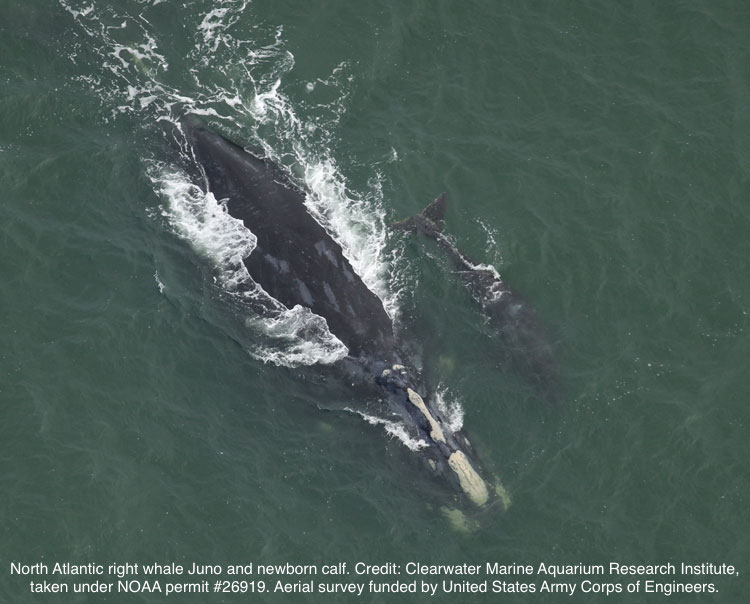Juno and her calf are the first spotted in the 2023-24 season!
Advocates for the North Atlantic right whale eagerly await the calving season each year, as mothers travel south from Canada and New England waters to the warmer waters of the Southeast to have their babies. Each mother calf pair is counted and tracked to try to help save this species from becoming extinct. The North Atlantic right whale has been on the endangered species list since 1970. In 2017, an Unusual Mortality Event was declared for the species, so every baby born is a reason to celebrate.
On November 23, 2023, a survey team spotted the first calf of the season! The mother was Juno (#1612) and they were spotted 7 miles off the coast of Georgetown, South Carolina! Juno is about 38 years old, and this is her eighth documented calf.

An Injured Calf
On January 3, 2024 fishermen off the coast of Edisto, South Carolina encounter Juno and her calf and are able to take video showing some devastating news. Juno’s calf had injuries that appeared to be consistent with a vessel strike. The propellor wounds seen were given a preliminary determination of a “serious injury” by NOAA Fisheries biologists. The wounds on the head, mouth, and left lip appeared to be likely to make it difficult for the calf to nurse successfully. When a “serious injury” determination is made, it means the whale is likely to die as a result.

Spotted near Amelia Island
On January 11, 2024, Juno and her calf were spotted near Amelia Island. The wounds were severe, but did show some evidence of healing. The risk of internal injuries, infection, or impaired behavior (difficulty nursing) were still of great concern. As you can see in the picture below, the whale’s injuries are covered with a large amount of whale lice. Whale lice can be a sign of health decline.

Sighted off Sapelo Island, Georgia
Juno and her injured calf were once again spotted by aerial and vessel surveys on February 1, 2024 23 miles east of Sapelo Island, Georgia. Researchers observed what appeared to be nursing, but were still very concerned about the calf’s injuries.

Sighting off the coast of Georgia
On February 27, 2024, just 2 miles off the coast of St. Simons Island, Georgia, Juno and her calf were spotted by aerial and vessel survey teams. There was no visible bleeding from the wounds. Aerial and vessel survey teams spotted Juno and her calf on February 28, 2024 off the coast of St. Andrew Sound, Georgia. The wound was bleeding.

Juno is spotted without her calf
Off the coast of St. Augustine, Florida, Juno is spotted without her calf on March 2, 2024.
Heartbreak on Cumberland Island, Georgia
On March 3, 2024, a dead North Atlantic right whale was reported stranded on Cumberland Island National Seashore in Georgia. NOAA Fisheries, along with the Georgia Department of Natural Resources and the Florida Fish and Wildlife Conservation Commission, identified the whale as the calf of Juno #1612. The carcass had been heavily scavenged by sharks.

The Necropsy
A necropsy was performed by experts on March 4, 2024. The findings showed multiple lacerations on the head from a vessel strike. The lacerations had penetrated deep into the soft tissue and bone, leading to multiple sites of necrosis (tissue death). See the full write up of Juno’s calf’s story by the NOAA Fisheries here.

Unusual Mortality Event
Tragically, only four months into its life, Juno’s calf was added to the list of those whales that are a part of the Unusual Mortality Event. Since 2017, 123 individual whales have been affected: 39 dead, 33 seriously injured, and 51 sublethally injured or ill. The primary causes of the Unusual Mortality Event are vessel strikes and entanglements in fishing gear.
Why Do Vessel Strikes Happen?
North Atlantic right whales are bigger than school buses (up to 52 feet in length). Calves are about 14 feet at birth. So why is a vessel strike such a threat to this species?
North Atlantic right whales are mostly black and they do not have a dorsal fin that sticks up from the water, which makes it difficult to see them in the water. While they are in the calving grounds, you can often find them near the surface, quietly resting, nursing their calves. They can be near shore or further offshore. They often look like logs floating in the water.
If you’re boating during the calving season in the calving grounds, please slow down, post a lookout, and report any whale sightings. Sightings can be reported to the Right Whale Sighting Network at 888-97-WHALE (888-979-4253).

